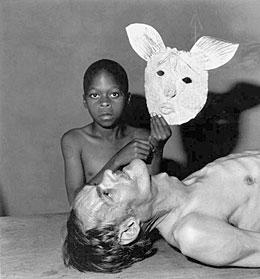Roger Ballen
dal 12/5/2004 al 15/8/2004
Segnalato da
12/5/2004
Roger Ballen
Berkeley Art Museum and Pacific Film Archive BAM/PFA, Berkeley
Photographs. Roger Ballen's stark, unsettling black-and-white photographs of the white underclass of South Africa present a chilling view of a dysfunctional society and, by extension, the contemporary human condition.

Roger Ballen's stark, unsettling black-and-white photographs of the white underclass of South Africa present a chilling view of a dysfunctional society and, by extension, the contemporary human condition.
Ballen's photographs became known to a wide public following the publication of his book Outland in 2001. He has been compared to Diane Arbus in that both photographers depict extra-ordinary individuals. Similarities to Joel-Peter Witkin also have not gone unnoticed: both artists construct mysterious and disturbing scenes that somehow suggest drawing rather than photography. Like Walker Evans's Depression-era documents of the rural South, Ballen's images often locate their subjects in bare, squalid interiors. But in the end, Ballen's photographs are completely his own. Like characters in Samuel Beckett's black comedies, his subjects are alone in a seemingly meaningless and cruel world.
The artist made the majority of the works on view in this exhibition in South Africa's rural towns known as dorps. These towns are populated by whites whose economic and social condition has worsened since the end of apartheid, reflecting the complex reality of a society that for so long tried to suppress and deny the black majority. Although at first Ballen shot outdoors, before long he moved his camera into the living quarters of the dorps' inhabitants and turned from a mostly documentary approach to one closer to fiction. Even in his most politically charged works, Ballen claims personal expression to be his primary interest.
The people in Ballen's photographs, alone or in small groups, stare vacantly or sometimes menacingly at the camera. If any interaction is depicted, it tends to be between humans and animals in scenarios that verge on the sadistic. However, Ballen's attitude towards his subjects is not that of a stranger. He returns again and again to their villages, getting to know the people and their desperation. While fascinating to Ballen, the actors in his tableaux are not portrayed voyeuristically or as objects of ridicule. These images are not without empathy, humor, or beauty even while they may evoke horror.
In his newest works, in which Ballen is less focused on portraiture, we can see an increased concentration on still life and the influence of contemporary painting and sculpture. In the artist's words, “Their meaning for me transcended the social and political to the aesthetic.†Ballen's interiors are dominated by lines—electrical cords traverse the decayed walls of empty rooms that may also display crude drawings, graffiti, and wire sculptures installed by the artist. When humans or animals are present they are posed as actors in orchestrated tableaux. The result is an intriguing interplay between documentary photography and theater. The worldview evoked in Ballen's work is as consistent with the dark vision of an artist such as Damien Hirst, who uses animals as surrogates to comment on contemporary society, as with the work of other contemporary photographers.
Born in New York in 1950, Ballen received an undergraduate degree in geology from UC Berkeley in 1972 and went on to earn a Ph.D. at the University of Colorado. He earns his living as a mining engineer in Johannesburg, where he has lived since 1974. Ballen sees a metaphoric relationship between geology and photography in that both reach deeper levels by probing the surface.
Although he received no formal training in photography, Ballen began taking pictures with his first camera at the age of thirteen. As a teenager, he was exposed to photojournalists at the Magnum agency, where his mother worked. His first role model was Henri Cartier-Bresson, who emphasized seizing the “decisive moment.†Andre Kertesz was another of his early heroes; Kertesz's blend of documentation and surrealism finds echoes in Ballen's mature work.
Roger Ballen: Photographs is the first museum exhibition in the United States of this artist whose work is relatively well known in Europe and found in the collections of major museums in the United States and Europe as well as South Africa. Ballen's photographs have been published in several books including Platteland (1996) and Outland; Animals is forthcoming in 2005 from Phaidon Press.
Constance Lewallen
Senior Curator for Exhibitions
Roger Ballen: Photographs was curated and organized by Rachel Teagle, Assistant Curator, Museum of Contemporary Art San Diego, and organized for BAM/PFA by Constance Lewallen, Senior Curator for Exhibitions.
The exhibition was originated by the Museum of Contemporary Art San Diego and made possible in part by the annual contributions of stART Up, MCASD's support group of young professionals, and an anonymous gift. Additional support was provided by the City of San Diego Commission for the Arts and Culture.
Image: Roger Ballen: Tommy, Samson and a mask, 2000; selenium toned gelatin silver print; 14 1/8 x 14 in.
BAM/PFA
24-Hour General Information: (510) 642-0808
2626 Bancroft Way
2621 Durant Avenue
Berkeley



